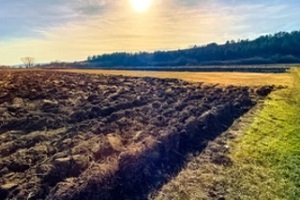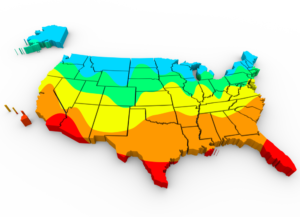The Benefits of Forestry Mulching: Enhancing Landscapes and Promoting Sustainable Land Management
 In today’s world, sustainability and responsible land management are more important than ever. Forestry mulching is a powerful tool that can improve landscapes and help conserve the environment. It clears land, controls invasive species, and creates protective barriers. Property owners and land managers can benefit greatly from using forestry mulching.
In today’s world, sustainability and responsible land management are more important than ever. Forestry mulching is a powerful tool that can improve landscapes and help conserve the environment. It clears land, controls invasive species, and creates protective barriers. Property owners and land managers can benefit greatly from using forestry mulching.
One major benefit of forestry mulching is that it improves soil health and prevents erosion. The process leaves a layer of organic mulch on the ground, which helps retain moisture and suppress weeds. This mulch also reduces soil erosion caused by wind and water. It protects the soil structure and encourages the growth of beneficial microorganisms, resulting in healthier and more fertile soil.
Forestry mulching is also a sustainable alternative to traditional land clearing methods, such as burning or mechanical clearing. By grinding up trees, shrubs, and vegetation into mulch, it eliminates the need for hauling debris elsewhere. This not only reduces waste but also minimizes the impact on surrounding ecosystems and preserves the land’s natural beauty.
In this article, we will explore the many benefits of forestry mulching in detail. We will highlight how it can enhance landscapes and support sustainable land management.
What is Forestry Mulching?
 Forestry mulching is a land clearing technique that uses specialized equipment to grind and shred vegetation, trees, and other woody materials into a fine, nutrient-rich mulch. Unlike traditional methods like burning or mechanical removal, forestry mulching leaves the resulting mulch on the ground. This mulch decomposes and enriches the soil.
Forestry mulching is a land clearing technique that uses specialized equipment to grind and shred vegetation, trees, and other woody materials into a fine, nutrient-rich mulch. Unlike traditional methods like burning or mechanical removal, forestry mulching leaves the resulting mulch on the ground. This mulch decomposes and enriches the soil.
This technique works well in areas with dense undergrowth, overgrown shrubs, or small trees. It’s useful for creating firebreaks, improving access to land, or preparing the ground for new development or farming. The equipment used in forestry mulching can handle a wide range of vegetation, from delicate plants to larger trees.
By turning cleared vegetation into a protective, moisture-retaining layer of mulch, forestry mulching benefits both the environment and the land being managed. This innovative approach not only enhances the appearance of the landscape but also promotes long-term soil health and ecosystem restoration.
Understanding the Environmental Benefits of Forestry Mulching
 One of the main environmental benefits of forestry mulching is its ability to improve soil health and prevent erosion. As the mulch decomposes, it releases valuable nutrients back into the soil. This provides a natural and sustainable source of organic matter. The enriched soil supports the growth of native plants, which attract diverse wildlife and contribute to the area’s ecological balance.
One of the main environmental benefits of forestry mulching is its ability to improve soil health and prevent erosion. As the mulch decomposes, it releases valuable nutrients back into the soil. This provides a natural and sustainable source of organic matter. The enriched soil supports the growth of native plants, which attract diverse wildlife and contribute to the area’s ecological balance.
Additionally, the mulch layer helps retain moisture in the soil, reducing the risk of drought and lessening the need for extra irrigation. This is especially important in areas where water is scarce, as it allows for more efficient and responsible land management.
Another significant benefit is that forestry mulching controls the spread of invasive species. By grinding up invasive plants and incorporating them into the soil, the mulching process prevents these species from regrowing and outcompeting native plants. This helps maintain ecological balance and preserve the area’s natural biodiversity.
Enhancing Landscapes with Forestry Mulching
 Forestry mulching can greatly enhance the visual appeal of a landscape. By clearing away overgrown vegetation and leaving behind a uniform layer of mulch, this process can transform neglected areas into well-maintained spaces.
Forestry mulching can greatly enhance the visual appeal of a landscape. By clearing away overgrown vegetation and leaving behind a uniform layer of mulch, this process can transform neglected areas into well-maintained spaces.
This is particularly beneficial for property owners, land managers, and municipalities looking to improve the appearance of outdoor spaces. Whether it’s a residential property, a commercial development, or a public park, the mulch provides a clean look while accentuating the landscape’s natural features.
Additionally, forestry mulching can create a more cohesive and harmonious landscape design. The consistent and well-maintained appearance throughout the cleared areas contributes to the overall aesthetic appeal of the property. This makes it more visually inviting to visitors and residents alike.
Promoting Sustainable Land Management through Forestry Mulching
 Forestry mulching supports sustainable land management by promoting the responsible use of natural resources. Unlike traditional land clearing methods that often involve disposing of vegetation and debris, forestry mulching keeps the cleared materials on-site, where they decompose and enrich the soil.
Forestry mulching supports sustainable land management by promoting the responsible use of natural resources. Unlike traditional land clearing methods that often involve disposing of vegetation and debris, forestry mulching keeps the cleared materials on-site, where they decompose and enrich the soil.
This approach reduces waste and minimizes the environmental impact of land clearing. By retaining organic matter and nutrients in the soil, forestry mulching ensures the land remains healthy and productive for future use.
Moreover, the sustainable nature of forestry mulching extends beyond the land clearing process. The improved soil health and moisture retention lead to reduced water usage, decreased reliance on chemical fertilizers, and a lower carbon footprint. This makes forestry mulching a valuable tool in the broader effort to promote sustainable land management and address environmental challenges.
Key Advantages of Using Forestry Mulching for Land Clearing
 Forestry mulching offers many advantages over traditional land clearing methods. One primary benefit is its reduced impact on the surrounding environment.
Forestry mulching offers many advantages over traditional land clearing methods. One primary benefit is its reduced impact on the surrounding environment.
Unlike burning or mechanical clearing, which can disrupt natural habitats and leave soil vulnerable to erosion, forestry mulching leaves the ground covered in a protective layer of organic material. This preserves existing vegetation, maintains soil structure, and minimizes disturbance to the local ecosystem.
Another advantage is the versatility of forestry mulching. The specialized equipment can handle various vegetation types, from small shrubs and undergrowth to larger trees and wood debris. This makes forestry mulching suitable for many land clearing projects, including creating firebreaks, improving access, and preparing sites for development or farming.
How Forestry Mulching Helps Prevent Erosion and Soil Degradation
 Forestry mulching is highly effective at preventing soil erosion and degradation. The mulch layer left on the ground stabilizes the soil and reduces the impact of wind, water, and other natural forces that can cause soil loss.
Forestry mulching is highly effective at preventing soil erosion and degradation. The mulch layer left on the ground stabilizes the soil and reduces the impact of wind, water, and other natural forces that can cause soil loss.
The organic matter in the mulch acts as a barrier, absorbing rainfall impact and preventing soil from washing away. It also retains moisture in the soil, reducing the risk of drought and maintaining the land’s overall health and fertility.
As the mulch decomposes, it releases nutrients back into the soil. This replenishes natural resources and supports the growth of healthy vegetation. This process prevents soil depletion and ensures the land’s long-term sustainability, making it an essential part of responsible land management.
The Cost-Effectiveness of Forestry Mulching Compared to Traditional Land Clearing Methods
 Forestry mulching is also more cost-effective than traditional land clearing methods. By eliminating the need to haul and dispose of debris, it significantly reduces operational costs.
Forestry mulching is also more cost-effective than traditional land clearing methods. By eliminating the need to haul and dispose of debris, it significantly reduces operational costs.
The long-term benefits of forestry mulching, such as improved soil health, reduced erosion, and enhanced landscape aesthetics, can lead to ongoing savings for property owners and land managers. For example, better soil quality can reduce water and fertilizer use, while an enhanced landscape can increase property values.
Furthermore, the specialized equipment used in forestry mulching is often more efficient than traditional methods, allowing for faster land clearing operations. This can result in significant time and labor savings, further adding to the cost-effectiveness of this approach.
Case Studies Showcasing Successful Forestry Mulching Projects
To illustrate the real-world benefits of forestry mulching, let’s look at a few success stories.
One example is a residential property in a wooded area overgrown with dense vegetation. The homeowners used forestry mulching to clear the land and create an inviting outdoor space. The process improved the property’s appearance and enhanced soil quality, allowing for a thriving garden and landscape.
Another case study involves a commercial development project where the land was overrun with invasive species. The developers used forestry mulching to clear the land and prepare it for construction. The mulch suppressed the invasive plants and encouraged native species, contributing to the site’s ecological balance.
Finally, a neglected municipal park was revitalized through forestry mulching. The local authorities saw this technique’s potential to enhance the park’s appearance and improve the visitor experience. The process cleared overgrown areas and left a uniform, well-maintained layer of mulch, making the park more inviting.
Finding a Professional Land Clearing Service Provider
 When considering land clearing for your property, it’s essential to work with a reputable service provider. These professionals have the specialized equipment and expertise to complete the mulching process efficiently while minimizing environmental impact.
When considering land clearing for your property, it’s essential to work with a reputable service provider. These professionals have the specialized equipment and expertise to complete the mulching process efficiently while minimizing environmental impact.
When searching for a land management service provider, look for companies with a successful project track record and a commitment to sustainable practices. Ensure the provider is licensed, insured, and compliant with environmental regulations in your area.
Additionally, consider the services offered by the provider. Some may specialize in specific types of vegetation management or offer additional services like site preparation, erosion control, or ecosystem restoration. Working with an experienced land clearing service provider ensures your project will be completed in a way that maximizes environmental benefits and land sustainability.
How to Choose the Right Land Clearing Equipment
 Selecting the right equipment for vegetation management is crucial for a successful project. Different machines are designed to handle specific vegetation types and land conditions. For instance, a compact track loader might be ideal for smaller areas with light underbrush, while a more powerful mulcher attachment is better suited for dense forests and larger trees. When choosing equipment, consider the terrain, vegetation density, and the specific goals of your project. Consulting with a professional land clearing service can help you make the best choice, ensuring efficient clearing and optimal results.
Selecting the right equipment for vegetation management is crucial for a successful project. Different machines are designed to handle specific vegetation types and land conditions. For instance, a compact track loader might be ideal for smaller areas with light underbrush, while a more powerful mulcher attachment is better suited for dense forests and larger trees. When choosing equipment, consider the terrain, vegetation density, and the specific goals of your project. Consulting with a professional land clearing service can help you make the best choice, ensuring efficient clearing and optimal results.
Steps to Prepare Your Land for Forestry Mulching
Proper preparation is key to a successful forestry mulching project. Before starting, assess the land to identify any obstacles like large rocks, stumps, or debris that could hinder the mulching process. It’s also important to mark any areas that require special attention, such as utility lines or sensitive habitats. Clearing the land of any movable objects and determining the boundaries of the area to be mulched can help streamline the process. By preparing your land correctly, you’ll ensure a smoother, more efficient mulching operation, leading to better outcomes.
Safety Considerations in Forestry Mulching
 Safety should always be a top priority in forestry mulching. The equipment used is powerful and requires careful operation. Ensure that all operators are trained and experienced with the machinery to prevent accidents. It’s also important to wear appropriate safety gear, including helmets, gloves, and protective eyewear. Additionally, establish a clear communication plan among workers to coordinate movements and avoid hazards. Always keep a safe distance from active machinery and be aware of your surroundings, especially when working in areas with uneven terrain or near power lines.
Safety should always be a top priority in forestry mulching. The equipment used is powerful and requires careful operation. Ensure that all operators are trained and experienced with the machinery to prevent accidents. It’s also important to wear appropriate safety gear, including helmets, gloves, and protective eyewear. Additionally, establish a clear communication plan among workers to coordinate movements and avoid hazards. Always keep a safe distance from active machinery and be aware of your surroundings, especially when working in areas with uneven terrain or near power lines.
Understanding the Costs Involved in Forestry Mulching
The costs of forestry mulching can vary depending on several factors, including the size of the area, the type of vegetation, and the equipment used. Generally, larger areas with dense vegetation will require more time and resources, increasing the overall cost. However, forestry mulching can be more cost-effective than traditional land clearing methods because it eliminates the need for debris removal and disposal. Additionally, the long-term benefits, such as improved soil health and reduced maintenance, can lead to cost savings over time. Understanding these factors can help you budget effectively for your project.
Forestry Mulching for Fire Prevention and Control
 Forestry mulching is an effective method for creating firebreaks and reducing wildfire risks. By clearing underbrush, small trees, and other potential fuel sources, forestry mulching helps to prevent the spread of fires. The mulch left behind acts as a protective layer, reducing the likelihood of ignition and slowing the spread of any fires that do occur. This technique is especially valuable in areas prone to wildfires, where proactive land management can protect properties and ecosystems. Incorporating forestry mulching into your fire prevention strategy can enhance safety and reduce the impact of wildfires.
Forestry mulching is an effective method for creating firebreaks and reducing wildfire risks. By clearing underbrush, small trees, and other potential fuel sources, forestry mulching helps to prevent the spread of fires. The mulch left behind acts as a protective layer, reducing the likelihood of ignition and slowing the spread of any fires that do occur. This technique is especially valuable in areas prone to wildfires, where proactive land management can protect properties and ecosystems. Incorporating forestry mulching into your fire prevention strategy can enhance safety and reduce the impact of wildfires.
Comparing Forestry Mulching with Other Land Clearing Methods
When comparing forestry mulching to other land clearing methods, several advantages stand out. Unlike traditional methods such as burning or mechanical removal, forestry mulching leaves the land covered in organic mulch, which improves soil health and reduces erosion. Additionally, it is a more environmentally friendly option, as it minimizes waste and preserves the natural landscape. While other methods may be faster for certain projects, forestry mulching offers long-term benefits that often outweigh the initial investment. Understanding these differences can help you choose the best approach for your land management needs.
Common Challenges in Forestry Mulching and How to Overcome Them
 Forestry mulching, like any land management technique, can present challenges. One common issue is dealing with rocky or uneven terrain, which can make it difficult for the equipment to operate efficiently. To overcome this, it’s important to conduct a thorough site assessment before beginning the project and to select the appropriate machinery for the conditions. Another challenge is managing regrowth in areas where invasive species were cleared. Regular monitoring and follow-up treatments can help prevent these plants from re-establishing. By anticipating these challenges, you can ensure a successful forestry mulching project.
Forestry mulching, like any land management technique, can present challenges. One common issue is dealing with rocky or uneven terrain, which can make it difficult for the equipment to operate efficiently. To overcome this, it’s important to conduct a thorough site assessment before beginning the project and to select the appropriate machinery for the conditions. Another challenge is managing regrowth in areas where invasive species were cleared. Regular monitoring and follow-up treatments can help prevent these plants from re-establishing. By anticipating these challenges, you can ensure a successful forestry mulching project.
How Forestry Mulching Supports Wildlife Habitat Restoration
Forestry mulching plays a vital role in restoring wildlife habitats. By selectively clearing overgrown areas, it promotes the growth of native plants that provide food and shelter for local wildlife. The mulch layer helps maintain soil moisture and reduces erosion, creating a more stable environment for plants and animals. Additionally, forestry mulching can help control invasive species that threaten native ecosystems, allowing native flora and fauna to thrive. This method is especially useful in habitat restoration projects where the goal is to enhance biodiversity and support a healthy ecosystem.
Sustainable Agriculture and Mulching
 Eco-friendly mulching techniques play a vital role in sustainable agriculture. By clearing land while preserving soil health and preventing erosion, they help create a fertile environment for crops and livestock. The organic mulch left behind enriches the soil with nutrients, reducing the reliance on chemical fertilizers. Additionally, these methods aid in managing water resources by retaining soil moisture, crucial in drought-prone areas. Farmers and land managers who adopt these practices can enhance land productivity while maintaining ecological balance.
Eco-friendly mulching techniques play a vital role in sustainable agriculture. By clearing land while preserving soil health and preventing erosion, they help create a fertile environment for crops and livestock. The organic mulch left behind enriches the soil with nutrients, reducing the reliance on chemical fertilizers. Additionally, these methods aid in managing water resources by retaining soil moisture, crucial in drought-prone areas. Farmers and land managers who adopt these practices can enhance land productivity while maintaining ecological balance.
Frequently Asked Questions About Mulching Techniques
Mulching is a versatile land management technique, and it’s common to have questions about how it works. Some frequently asked questions include: How long does the process take? What types of vegetation can be mulched? Is this method suitable for all types of terrain? The answers vary based on the specific project, but generally, this technique is a quick, efficient way to clear land. It can handle a wide range of vegetation types and adapts well to various terrains. Consulting with a professional mulching service can provide more detailed answers tailored to your needs.
Embracing Forestry Mulching for a Greener and More Sustainable Future
 As we work toward a more sustainable world, forestry mulching stands out as a valuable tool in responsible land management. By turning cleared vegetation into nutrient-rich mulch, this technique offers benefits that go beyond land clearing.
As we work toward a more sustainable world, forestry mulching stands out as a valuable tool in responsible land management. By turning cleared vegetation into nutrient-rich mulch, this technique offers benefits that go beyond land clearing.
From enhancing landscape aesthetics and supporting healthy ecosystems to preventing soil erosion and promoting sustainable development, forestry mulching is versatile and valuable. As more people embrace this approach, we can collectively work toward a greener future where human activity and nature coexist harmoniously.
By choosing forestry mulching over traditional land clearing methods, you help preserve natural resources, restore healthy ecosystems, and create vibrant, resilient communities. As we continue to explore and adopt innovative solutions like forestry mulching, we pave the way for a sustainable and prosperous future that benefits the environment and the communities it supports.
Understanding the Environmental Impact of Traditional Land Clearing Methods
 Traditional land clearing methods, such as burning or mechanical removal, can have significant negative impacts on the environment. Burning vegetation releases harmful emissions into the air, contributing to air pollution and greenhouse gas accumulation. Mechanical removal, on the other hand, often results in soil compaction, which can degrade soil health and increase erosion. These methods also typically require the removal and disposal of debris, leading to additional waste. In contrast, forestry mulching offers an eco-friendly alternative that minimizes environmental disruption while maintaining the natural balance of the land.
Traditional land clearing methods, such as burning or mechanical removal, can have significant negative impacts on the environment. Burning vegetation releases harmful emissions into the air, contributing to air pollution and greenhouse gas accumulation. Mechanical removal, on the other hand, often results in soil compaction, which can degrade soil health and increase erosion. These methods also typically require the removal and disposal of debris, leading to additional waste. In contrast, forestry mulching offers an eco-friendly alternative that minimizes environmental disruption while maintaining the natural balance of the land.
Forestry Mulching for Residential vs. Commercial Projects
Forestry mulching is a versatile solution that can be tailored to both residential and commercial projects. For residential properties, it’s often used to clear overgrown areas, improve landscape aesthetics, and create firebreaks around homes. In commercial settings, forestry mulching is ideal for large-scale land clearing, site preparation, and managing invasive species. Whether you’re a homeowner looking to enhance your yard or a developer preparing land for construction, forestry mulching provides a sustainable, efficient way to achieve your goals.
Seasonal Considerations for Forestry Mulching Projects
 The timing of your forestry mulching project can greatly impact its success. In many cases, fall and winter are ideal seasons for mulching because the ground is more stable, and there’s less risk of disturbing active wildlife. However, spring and summer might be better suited for projects that require quick vegetation regrowth, as warmer weather promotes faster recovery. It’s important to plan your project according to the specific needs of your land and the local climate, ensuring optimal results throughout the year.
The timing of your forestry mulching project can greatly impact its success. In many cases, fall and winter are ideal seasons for mulching because the ground is more stable, and there’s less risk of disturbing active wildlife. However, spring and summer might be better suited for projects that require quick vegetation regrowth, as warmer weather promotes faster recovery. It’s important to plan your project according to the specific needs of your land and the local climate, ensuring optimal results throughout the year.
Long-Term Benefits of Forestry Mulching for Property Value
 Forestry mulching offers long-term benefits that can significantly enhance the value of your property. By improving soil health, preventing erosion, and creating a more attractive landscape, mulching makes your land more appealing to potential buyers or tenants. Well-maintained land with healthy vegetation is also easier to manage and less costly to maintain over time. Additionally, the sustainable practices used in forestry mulching can attract eco-conscious buyers, further increasing your property’s marketability.
Forestry mulching offers long-term benefits that can significantly enhance the value of your property. By improving soil health, preventing erosion, and creating a more attractive landscape, mulching makes your land more appealing to potential buyers or tenants. Well-maintained land with healthy vegetation is also easier to manage and less costly to maintain over time. Additionally, the sustainable practices used in forestry mulching can attract eco-conscious buyers, further increasing your property’s marketability.
Forestry Mulching and Wildlife Preservation
Forestry mulching is a valuable tool for preserving wildlife habitats while managing land effectively. By selectively clearing overgrown areas, it helps maintain the natural environment that local wildlife depends on for food and shelter. The organic mulch left behind supports native plant growth, which in turn provides a healthy ecosystem for animals. This method also minimizes the impact on the land, ensuring that habitats are preserved rather than destroyed, making forestry mulching an ideal choice for conservation-minded property owners.
How to Maintain Your Land After Forestry Mulching
 After completing a forestry mulching project, proper maintenance is key to ensuring long-lasting benefits. Regularly monitor the mulched area for regrowth of unwanted vegetation, and consider additional mulching or spot treatments if necessary. Maintaining the mulch layer helps retain soil moisture, suppress weeds, and prevent erosion. It’s also important to periodically assess the health of the soil and vegetation, making adjustments as needed to promote continued growth and land stability. With proper care, your land will remain healthy, attractive, and sustainable for years to come.
After completing a forestry mulching project, proper maintenance is key to ensuring long-lasting benefits. Regularly monitor the mulched area for regrowth of unwanted vegetation, and consider additional mulching or spot treatments if necessary. Maintaining the mulch layer helps retain soil moisture, suppress weeds, and prevent erosion. It’s also important to periodically assess the health of the soil and vegetation, making adjustments as needed to promote continued growth and land stability. With proper care, your land will remain healthy, attractive, and sustainable for years to come.
Choose Expert Forestry Mulching Services in the Maryland, Virginia, and Washington, D.C. Metro Area
 If you’re looking for reliable and professional forestry mulching services in the Maryland, Virginia, and Washington, D.C. metro area, look no further. Our team of experienced professionals is committed to delivering top-quality land management solutions tailored to your specific needs. With our state-of-the-art equipment and dedication to sustainable practices, we ensure that your land is cleared efficiently and responsibly. Whether you need vegetation control, erosion prevention, or site preparation, we are here to help you achieve the best results for your property. Contact us today to learn more about how we can assist with your next project.
If you’re looking for reliable and professional forestry mulching services in the Maryland, Virginia, and Washington, D.C. metro area, look no further. Our team of experienced professionals is committed to delivering top-quality land management solutions tailored to your specific needs. With our state-of-the-art equipment and dedication to sustainable practices, we ensure that your land is cleared efficiently and responsibly. Whether you need vegetation control, erosion prevention, or site preparation, we are here to help you achieve the best results for your property. Contact us today to learn more about how we can assist with your next project.
Summary

Dirt Connections was started with one goal in mind: providing quality residential and commercial construction services to clients on time and on budget. Reach out for more information on how we can support your next project.
For your convenience our estimates are free and by appointment. Call 703-940-9949 for a free estimate today!











































